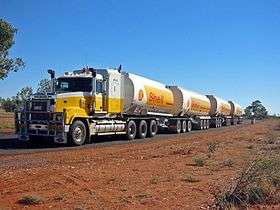Cabin (truck)
-2003.jpg)
Renault Premium cabover with sleeper

Kenworth aerodynamic hood without sleeper

Mack hooded Road Train truck with sleeper
The cabin or cab of a truck is an enclosed space in a truck where the driver is seated. Modern long-haul trucks cabs usually feature air conditioning, heater, a good sound system, and ergonomic seats (often air-suspended).
A sleeper (or sleeper berth or bunk) is a compartment attached to the cab where the driver can rest while not driving, sometimes seen in semi-trailer trucks. They can range from a simple 2 to 4 foot (0.6 to 1.2 m) bunk to a 12 foot (3.7 m) apartment-on-wheels. There are a few possible cab configurations:
- Cab over engine (COE) or flat nose, where the driver is seated on top of the front axle and the engine. The front doors are typically in front of and above the front tires. This design is almost ubiquitous in Europe, where overall truck lengths are strictly regulated. They were common in the United States and Canada but such body style in heavy duty type trucks lost prominence, when the legally permitted length was extended in the early 1980s. Nevertheless, COE's are still popular among medium and light duty trucks in the United States. To access the engine, the whole cab tilts forward, earning this design the name of tilt-cab. This type of cab is especially suited to the delivery conditions in Europe where many roads follow the layout of much more ancient path and trackways which require the additional turning capability of the cab over engine type. The operating conditions of these vehicles tend to be cooler than the conventional cab design and so the increased engine surface area used for cooling in hotter climates is not required. Access to a COE cab is commonly by steps forward of the front tires.
- Conventional cabs are the most common in North America and Australia. The driver is seated behind the engine, as in most passenger cars or pickup trucks. Conventionals are further divided into large car and aerodynamic designs. A "large car" or "long nose" is a conventional truck with a long (6 to 8 foot (1.8 to 2.4 m) or more) hood. With their very square shapes, these trucks experience a lot of wind resistance and typically consume more fuel. They also provide somewhat poorer visibility than their aerodynamic or COE counterparts. By contrast, Aerodynamic cabs are very streamlined, with a sloped hood and other features to lower drag. The front doors are behind (and mostly above) the front tires. Access to a conventional cabin is commonly by steps at or near the fuel tank(s) behind the front tires.
- Cab beside engine designs also exist, but are rather rare.
- Slang terms
- Tiltin' Hilton or flying coffin - Cab-over with a sleeper berth.
- Anteater - Specifically refers to the Kenworth T600, an aerodynamically-designed tractor whose nose resembles an anteater.
- Large car - A conventional cab with a large square hood, such as the Freightliner Classic, Kenworth W900 or the Peterbilt 379.
This article is issued from
Wikipedia.
The text is licensed under Creative Commons - Attribution - Sharealike.
Additional terms may apply for the media files.